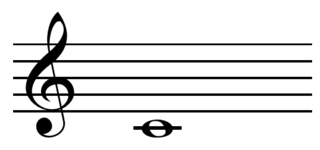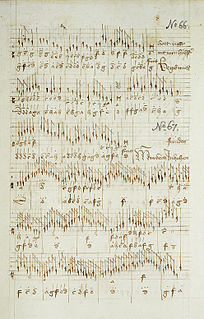
Music notation or musical notation is any system used to visually represent aurally perceived music played with instruments or sung by the human voice through the use of written, printed, or otherwise-produced symbols, including notation for durations of absence of sound such as rests.

In music, a note is a symbol denoting a musical sound. In English usage a note is also the sound itself.
In music, an accidental is a note of a pitch that is not a member of the scale or mode indicated by the most recently applied key signature. In musical notation, the sharp, flat, and natural symbols, among others, mark such notes—and those symbols are also called accidentals.

A clef is a musical symbol used to indicate which notes are represented by the lines and spaces on a musical stave. When a clef is placed on a stave it assigns a particular note to one of the five lines. This line becomes a reference point by which the names of the other notes on the stave are determined.

C or Do is the first note of the C major scale, the third note of the A minor scale, and the fourth note of the Guidonian hand, commonly pitched around 261.63 Hz. The actual frequency has depended on historical pitch standards, and for transposing instruments a distinction is made between written and sounding or concert pitch.
In Western musical notation, the staff (US) or stave (UK) is a set of five horizontal lines and four spaces that each represent a different musical pitch or in the case of a percussion staff, different percussion instruments. Appropriate music symbols, depending on the intended effect, are placed on the staff according to their corresponding pitch or function. Musical notes are placed by pitch, percussion notes are placed by instrument, and rests and other symbols are placed by convention.
A ledger line or leger line is used in Western musical notation to notate pitches above or below the lines and spaces of the regular musical staff. A line slightly longer than the note head is drawn parallel to the staff, above or below, spaced at the same distance as the lines within the staff.
In music, sharp, dièse, or diesis means higher in pitch. More specifically, in musical notation, sharp means "higher in pitch by one semitone ". Sharp is the opposite of flat, which is a lowering of pitch.

LilyPond is a computer program and file format for music engraving. One of LilyPond's major goals is to produce scores that are engraved with traditional layout rules, reflecting the era when scores were engraved by hand.
In music, transposition refers to the process or operation of moving a collection of notes up or down in pitch by a constant interval.
The shifting of a melody, a harmonic progression or an entire musical piece to another key, while maintaining the same tone structure, i.e. the same succession of whole tones and semitones and remaining melodic intervals.

Braille music is a braille code that allows music to be notated using braille cells so music can be read by visually impaired musicians. The system was incepted by Louis Braille.
The numbered musical notation, is a musical notation system widely used in music publications in China. It dates back to the system designed by Pierre Galin, known as Galin-Paris-Chevé system. It is comparable to the Gongche notation from the Tang Dynasty.

Organ tablature is a form of musical notation used by the north German Baroque organ school, although there are also forms of organ tablature from other countries such as Italy, Spain, Poland, and England. Portions of Johann Sebastian Bach's Orgelbüchlein are written in tablature, as are a great deal of the surviving manuscripts of the organ works of Dieterich Buxtehude and other north German organ composers of the Baroque era.

Mensural notation is the musical notation system used for European vocal polyphonic music from the later part of the 13th century until about 1600. The term "mensural" refers to the ability of this system to describe precisely measured rhythmic durations in terms of numerical proportions between note values. Its modern name is inspired by the terminology of medieval theorists, who used terms like musica mensurata or cantus mensurabilis to refer to the rhythmically defined polyphonic music of their age, as opposed to musica plana or musica choralis, i.e., Gregorian plainchant. Mensural notation was employed principally for compositions in the tradition of vocal polyphony, whereas plainchant retained its own, older system of neume notation throughout the period. Besides these, some purely instrumental music could be written in various forms of instrument-specific tablature notation.
Klavarskribo is a music notation system that was introduced in 1931 by the Dutchman Cornelis Pot (1885–1977). The name means "keyboard writing" in Esperanto. It differs from conventional music notation in a number of ways and is intended to be easily readable.
Notation plays a relatively minor role in the oral traditions of Indonesian gamelan but, in Java and Bali, several systems of gamelan notation were devised beginning at the end of the 19th century, initially for archival purposes.
Percussion notation is a type of musical notation indicating notes to be played by percussion instruments. As with other forms of musical notation, sounds are represented by symbols which are usually written onto a musical staff.

Systems of musical notation have been in use in China for over two thousand years. Different systems have been used to record music for bells and for the Guqin stringed instrument. More recently a system of numbered notes (Jianpu) has been used, with resemblances to Western notations.

The Dodeka Keyboard Design is an isomorphic keyboard invented and designed by Jacques-Daniel Rochat. It is similar to a piano keyboard but with only a single row of keys containing each chromatic note. The keys corresponding to C, E and A flat are highlighted to provide visual landmarks. The creators aimed to create a rational and chromatic approach to music and performance. As an isomorphic keyboard, any musical sequence or interval has the same shape in each of the 12 keys.










